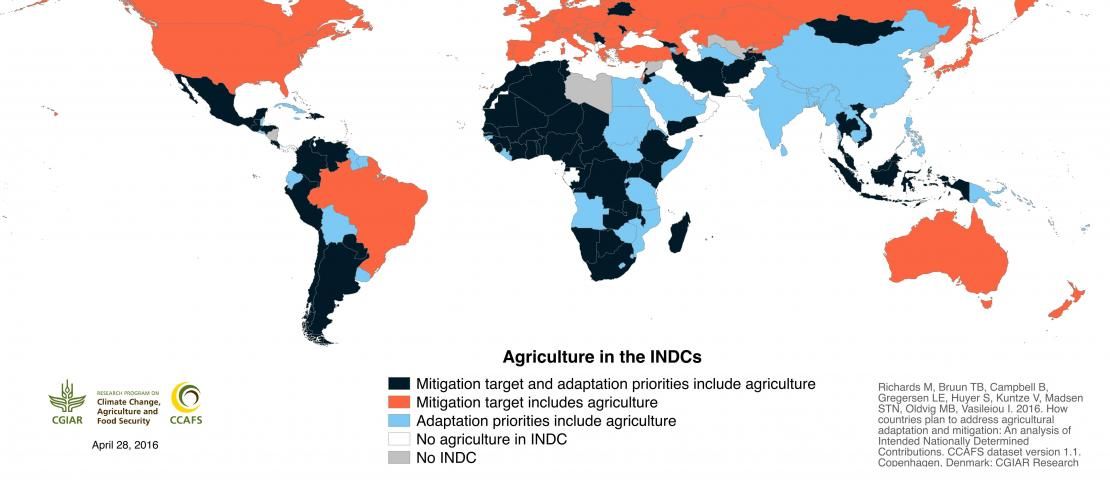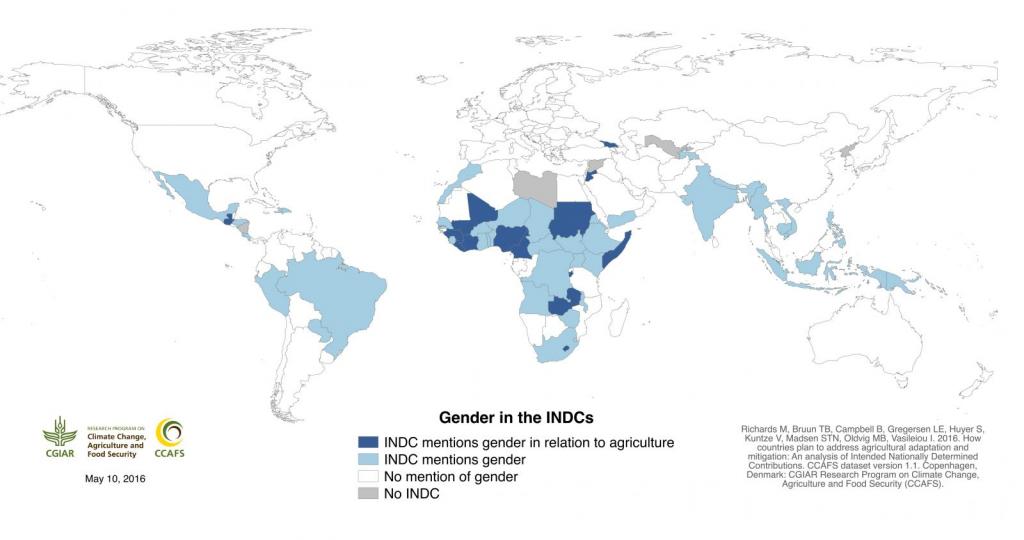Majority of climate change pledges to the UN include climate change adaptation and mitigation in agriculture

Most national climate change pledges – 177 of 189 – cite agriculture and land use as key strategies for achieving climate change adaptation or mitigation, or both.
Analysis of UN Parties' Intended Nationally Determined Contributions (INDCs) to climate action found that countries are looking to agriculture as both a source of emissions reductions and a sector that will require adaptation to meet future food needs.
Two reports were published in advance of COP21 in November 2015: Agriculture's prominence in the INDCs and How countries plan to address agricultural adaptation and mitigation. Now, the updated data and maps behind these studies are available, published in advance of the Subsidiary Body for Scientific and Technological Advice (SBSTA) meetings in May 2016. The data describes the country’s pledges in detail; a short synopsis follows.
Agricultural adaptation and mitiagtion measures
In the agriculture sector, Parties representing developed countries submitted INDCs for climate action that focused on mitigation. Parties representing developing countries linked adaptation and mitigation to their concerns for development, reducing social inequalities and achieving food security. Many Parties alluded to the close links between adaptation and mitigation.
Adaptation measures mentioned, by greatest number of Parties, were:
- Livestock management
- Crop management
- Fisheries and aquaculture management
- Irrigation management
- Knowledge transfer (e.g. extension)
- Agricultural diversification
- Soil and land management
- Climate-smart agriculture
- Early warning systems (e.g. seasonal forecasts)
- Agroforestry
- Agro-ecology
- Indigenous knowledge
- Financial mechanisms (e.g. crop insurance)
Agricultural mitigation measures mentioned, by greatest number of Parties, were:
- Livestock
- Croplands
- Grasslands
- Rice
- Manure management
- Agricultural residue management
- Fertilizer
- Agroforestry
- Climate-smart agriculture
- Agricultural intensification
Land use mitigation measures mentioned, by greatest number of Parties, were:
- Forest management
- Reforestation
- Avoided deforestation
- Afforestation
- Restoration of degraded land, soil, or forest
- Organic soils (e.g. peatlands)
- Soil carbon
- Coastal ecosystems (e.g. mangroves)
Anaylsis revealed less attention to services and incentives that will ensure uptake of practices.
Policies for agricultural adaptation and mitigation
Though Parties have significant variations in the degree to which climate change has been integrated into national policies, researchers found that most described policy dimensions support their INDCs, such as National Climate Policies or Strategies, National Adaptation Plans (NAPs), low emissions development strategies (LEDs), and Nationally Appropriate Mitigation Actions (NAMAs).
Capacity building, technology transfer, and finance
Analysis of the INDCs showed a focus on technologies and practices, and less attention to the enabling environments that will facilitate uptake, including knowledge management, technology transfer, and financing needs and mechanisms.
When these issues were raised, Parties stated expectations of support from the UNFCCC in the areas of finance, capacity building and technology transfer mechanisms. Many Parties noted capacity and technology transfer needs specific to agriculture as well, particularly around data collection, and monitoring, reporting and verification (MRV). Even those Parties with relatively well-developed policy environments noted the need for improved capacity and technology to implement their INDCs.
Most Parties from developing countries indicated the need for climate finance to achieve their targets. While some noted that some costs could be met domestically, more often they indicated need for international finance, or the possibility of more ambitious actions with international finance.
Parties mentioned the following types of finance:
- Adaptation finance
- Agricultural adaptation finance
- Mitigation finance
- Agricultural mitigation finance
- Private sector
Social inequality and food security
Researchers noted that Parties representing developing countries raised concerns of food and nutritional security, and poverty and social inequality. References in the INDCs to food security tended to be general, relating to recognition of the importance of achieving food security, taking measures to do so, and the national policy framework which supports food security. Gender references were confined mostly to impacts of climate change with less emphasis on supporting women to actively address and participate in adaptation and mitigation actions.
Several parties raised climate justice issues, particularly around responsibility for mitigation. Still, Parties representing developing countries may have exceeded Parties representing developed countries in ambition:
A recent civil society review of INDCs indicates that, based on historical responsibility and capacity to take action, poorer countries’ pledged actions meet their “fair share” of climate action, while wealthier countries’ pledges show a substantial gap in ambition.
Climate Equity Reference Project 2015
CCAFS is pursuing research on the issue of fair, ambitious and feasible targets at an official SBSTA side event in May, 2016.
In addition to CCAFS donors, the United States Agency for International Development (USAID) is also supporting this research.







